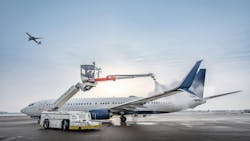Textron Debuts Safeaero 220E Electric Deicer for Wide Range of Aircraft
As aviation ground operations continue adapting to industry-wide demands for sustainability, efficiency and cost savings, equipment manufacturers are responding with new solutions designed to reduce emissions and streamline ramp activities.
Textron GSE has introduced its latest entry in this space: the Safeaero 220E, an all-electric aircraft deicer that combines lithium battery power with one-person operation and advanced fluid management technology.
Unveiled for international markets and CE-certified for use in Europe, the 220E marks a significant step for Textron’s Safeaero line, which has long been recognized for deicers capable of servicing both widebody aircraft and smaller fleets. By adding a lithium-electric drivetrain to the platform, Textron is signaling the company’s intention to bring deicing into alignment with broader electrification trends already reshaping ground support equipment (GSE) fleets worldwide.
Leadership perspective
Morgan Gresens, Vice President and General Manager of Textron GSE, said the 220E represents the latest stage in the company’s effort to update its flagship deicer platform, and it was featured at the International GSE Expo in Las Vegas in September.
“This is taking our 220 product and electrifying it, and it has been out on demo with many customers,” Gresens explained.
The company offered attendees a chance to see the unit up close at the show’s outdoor Demo Zone, where operators could climb into the cab and test the boom controls.
For Textron, the demonstration was an opportunity to showcase not only the 220E’s design but also its operating endurance. “We’re most proud that our vehicle can run just like a diesel-powered unit,” Gresens noted. “It can withstand a full day of de-icing before it has to be charged again. It’s a true single-operator deicer, meaning you drive it and de-ice from the cabin.
"What we’ve done is we’ve continued to invest in that technology, invest in upgrading it, and now we’ve electrified it,” she said.
One-person operation
One of the defining aspects of the 220E is its true single-operator capability. From within the cab, a single operator can drive, position and spray, eliminating the need for a second crewmember on the ground.
The machine is designed for maneuverability and reach. The cab-mounted boom offers a maximum nozzle height of 65.6 feet (20 meters), enabling service of widebody aircraft tails. The swing reach of 45.9 feet (14 meters) and telescoping arm range of 13.1 to 27.2 feet (4 to 8.3 meters) give operators flexibility across a diverse mix of aircraft, from business jets to long-haul airliners.
The system includes a four-mode nozzle control, allowing spray patterns to be adjusted to match different airframes and conditions. For detail work, a ground gun with a 32-foot hose reel provides precise application in hard-to-reach areas.
This single-operator approach is aimed at reducing labor demands on already stretched ground handling teams while maintaining consistency in fluid application.
Electric powertrain and charging
At the core of the 220E is a dual 109 kWh lithium nickel manganese cobalt (NMC) battery system, providing a total capacity of 218 kWh. Power is delivered through a liquid-cooled, high-torque AC motor, which Textron designed to deliver the necessary force for both driving and spraying operations.
The system supports 22 kW AC onboard charging as well as 120 kW DC fast charging, which gives operators flexibility depending on airport infrastructure.
While electric power has been a growing presence in tugs, belt loaders and baggage tractors, its use in large deicers has been limited until now. Bringing a high-capacity electric drivetrain to a machine of this scale demonstrates both the maturity of battery technology and the pressure on operators to reduce emissions at airports subject to sustainability mandates.
Fluid management and Intellimix technology
Beyond the power source, the 220E incorporates Textron’s Intellimix fluid management technology, designed to minimize waste and cut operating costs.
Traditionally, deicers flush fluid lines between different mixtures to maintain quality, which consumes both fluid and water. Intellimix eliminates the need for flushing by circulating and heating fluids while mixing them at the nozzle. The result is more precise blending of Type I and Type IV fluids and less wasted product.
For airlines and service providers, the potential savings in glycol consumption are significant. Deicing fluid is among the more expensive consumables on the ramp, and reductions in use translate directly into cost control. There are also environmental benefits: less fluid sprayed means less runoff to capture and treat.
The 220E carries a tank capacity of 2,232 gallons (8,450 liters), or 1,902 gallons (7,200 liters) with a heater, giving it the volume needed for sustained operations in busy hubs.
Operator experience and connectivity
Inside the cab, the 220E takes cues from the automotive world. Automotive steering controls are designed to simplify training and reduce the learning curve for new operators.
The unit also includes wireless data transfer and remote diagnostics, features increasingly common in next-generation GSE. These capabilities allow maintenance teams to track performance, monitor for emerging issues, and even conduct troubleshooting without taking the machine offline. For deicers, which often see intense seasonal demand followed by long idle periods, such monitoring can help extend service life and ensure readiness when winter weather arrives.
From an operations perspective, the ability to remotely monitor status across a fleet of deicers could enable more precise allocation of equipment and reduce unexpected downtime.
Broader industry context
The Safeaero 220E enters the market at a time when airports and airlines are under mounting pressure to decarbonize ground operations. European airports, in particular, face regulatory frameworks that encourage or mandate the reduction of fossil-fuel-powered equipment on the ramp. North American airports are also moving in this direction, with incentives and funding programs supporting electric GSE adoption.
Electric deicers present additional complexities compared to smaller vehicles, given their higher energy demands and fluid heating requirements. Textron’s approach with the 220E - large dual battery packs, liquid cooling, and fast-charging support - signals that these challenges are increasingly surmountable with current technology.
Another factor is workforce efficiency. Ground handling providers across regions continue to report labor shortages, especially during peak seasons. A single-operator deicer reduces staffing requirements while keeping aircraft turnaround times on schedule, aligning with operational priorities at busy airports.
Looking ahead
While Textron has not yet disclosed specific customer launch partners for the Safeaero 220E, the unit’s CE certification positions it for early adoption in European markets where sustainability requirements are most pressing. Broader rollout is expected as more airports and airlines pursue electrification strategies.
For ground support professionals, the 220E offers a glimpse into the evolving role of electric technology in high-demand, heavy-duty applications. It combines sustainability benefits with practical design choices intended to reduce costs and streamline operations, two of the primary drivers for GSE purchasing decisions.
As the industry prepares for another winter season, equipment like the Safeaero 220E reflects both the challenges and opportunities ahead: balancing safety and reliability in deicing operations while advancing toward a lower-emission future.

